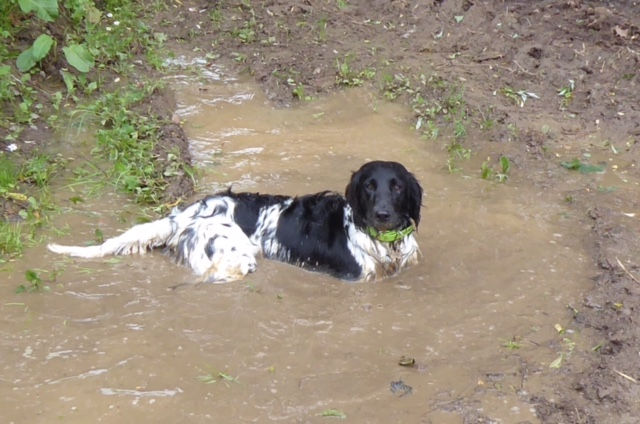Mermilmar Large Münsterländers
The Breed
Large Munsterlanders (LMs) are gundogs, part of the Hunt, Point and Retrieve (HPR) group, originally from the Munster region in Germany in the early 20th century. The first breed club was founded in Germany in 1919. Prior to this the LM had survived many attempts at eradication of the ‘black and whites’ but, fortunately, a group of German longhair breeders
decided that these should be officially recognised and decided to form them into a pure breed of gundog.
The ‘black and whites’ had shown a great aptitude for work and the way in which they worked, finding game in the close cover of the Munsterlands’ forests, thus suited both the game conditions and the geography of Munsterland. The Germans had spent many years trying to breed a high-quality all-round gundog and finally they succeeded. In 1922 the LM officially became a pure breed of gundog.
.jpeg)
Black and White German Longhair 1902
LMs were first imported to the UK in 1971 and the LM Club was formed in 1973. Ownership of an LM must be given serious consideration. They must be able to fit in with your lifestyle and equally, you must be able to fit in with theirs. They have numerous qualities; full of personality, making fabulous, loyal pets and companions, adoring human contact. They
are very versatile, but first and foremost we need to understand that they are Gundogs; a working dog part of the HPR group that makes them particularly intelligent with the capability to manage and think for themselves, sometimes making them not the easiest dogs to manage.
They need a lot of exercise, a couple of hours a day (and preferably for them, involving mud and water!). They are quite likely to be ‘prey’ driven, to a lesser or greater degree, and this is where we need to understand what motivates them and what makes them tick. HPRs were bred for a purpose and this purpose needs to be respected by owners. It is a careful balance
not to deprive them of their instinct, but to harness it in such a way that not only are they fulfilled but that we can manage and enjoy them too. Aside from regular daily exercise, if not worked it is good to stimulate them in some other activity where they can use their intelligence, energy and ability. See the ‘training and activities’ page.
Temperament and health checks on a pup’s sire and dam (and other family members) should be researched before deciding on a litter to buy from. This will include elbow and hip scoring, HC (hereditary cataracts) and HUU (Hyperuricosuria).
See the ‘contacts and useful links’ page for the Large Munsterlander Club and The Kennel Club website (health test finder) which have information on health testing.




The Breed Standard
General appearance - Alert and energetic, with strong muscular body, having good movement with drive.
Characteristics - Multi-purpose gundog, ideal for the rough shooter. Excellent nose, staying power, and works equally well on land and in water. A keen worker, easily taught.
Temperament - Loyal, affectionate and trustworthy.
Head and skull – Well-proportioned to body, elongated. Skull sufficiently broad, slightly rounded, with no pronounced occiput. Strong jaw muscles, well-formed black nose, wide soft nostrils, slight rise from the nasal bone to the forehead but no pronounced stop. Lips slightly rounded, and well fitting.
Eyes - Intelligent, medium size, dark brown, not deep-set or protruding. No haw showing.
Ears - Broad and set high, lying flat and close to the head, with a rounded tip. Hair on the ears should be long, extending beyond the tip.
Mouth - Strong and sound, with well-developed teeth, with a perfect, regular and complete scissor bite, i.e. upper teeth closely overlapping lower teeth and set square to the jaws.
Neck - Strong, muscular, slightly arched, joining the shoulder and chest smoothly. Forequarters - Chest, wide and with good depth of brisket. Shoulders laid well back, forelegs straight, pasterns strong.
Body - Firm, strong back, short coupled, slightly higher at the withers, sloping smoothly towards the croup and tail. Wide, well-muscled loin, wide croup, ribs well sprung, deep and reaching well up to the loin. Taut abdomen, slightly tucked up. Length of body, measured from point of shoulder to point of buttock should, ideally, be equal to height at withers, but may exceed height at withers by 2 cm.
Hindquarters - Hips broad. Well-muscled thighs, well-turned stifles, hocks well let down.
Feet - Tight, moderately rounded and well knuckled with dense hair between the toes, well padded. Strong nails.
Tail - Docked: Previously, docking of tip of tail was optional
Undocked: Well set on, in line with the back. Base thick, tapering evenly towards the tip, well feathered. It should be carried horizontally or curved slightly upwards.
Gait/movement - Free, long-striding, springy gait.
Coat - Hair long and dense, but not curly or coarse. Well feathered on front and hindlegs and on tail, more so in dogs than in bitches. Hair must lie short and smooth on the head.
Colour - Head solid black, white blaze, snip or star allowed. Body white or blue roan with black patches, flecked, ticked, or combination of these.
Size - Height: dogs: 60-65 cms (23½-25½ ins); bitches 58-63 cms (23-25 ins).
Faults - Any departure from the foregoing points should be considered a fault and the seriousness with which the fault should be regarded should be in exact proportion to its degree and its effect upon the health and welfare of the dog and on the dog’s ability to perform its traditional work.
Note
Male animals should have two apparently normal testicles fully descended into the scrotum.
Size – The Kennel Club breed standard is a guide and description of the ideal for the breed; the size as described does not imply that a dog will match the measurements given (height or weight). A dog might be larger or smaller than the size measurements stated in the breed standard.